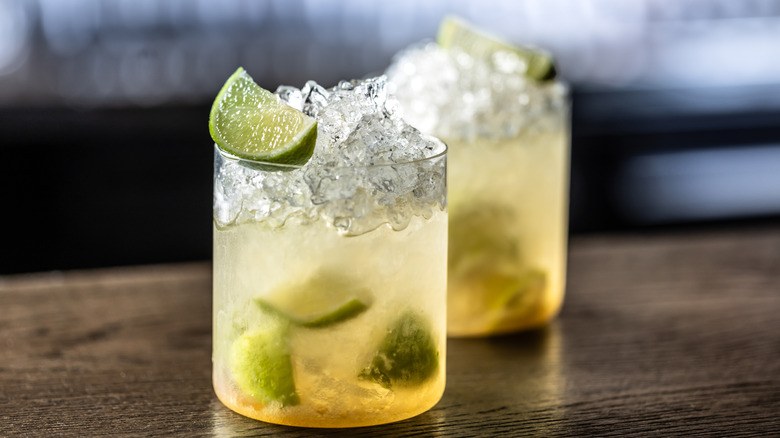The Classic 3-Ingredient Brazilian Cocktail Anthony Bourdain Loved 'The Pants Off' Of
Anthony Bourdain, the late great chef, writer, and TV presenter, taught more than a few invaluable lessons, whether it was reminding us never to order fish on a Monday, not to expect much from airplane meals, or to always follow the "Grandma Rule". His unpretentious, straight-shooting approach to food charmed and expanded countless horizons, and when Bourdain found something he genuinely loved, you could trust it was worth paying attention to.
On one of his trips to Brazil, Bourdain described the eclectic food scene as a kind of paradise. "Large cold beers and powerful beverages of crushed limes and sugarcane liquor, along with spicy fried things, seem to appear from all directions," he said. "It seems, from a visitor's point of view, utopian." The powerful beverage he referred to was none other than Brazil's pride and joy, the caipirinha — their national drink. He encountered this tart, margarita-esque mix of cachaça (a raw, fiery sugarcane spirit reminiscent of white rum), lime, sugar, and ice in a 2014 episode of "Parts Unknown." To him, it was more than just a refreshing beachside drink; he called it "an indispensable icon of Brazilian beach culture," and "the utility beverage good for any time of day, or any social occasion."
What appealed to Bourdain was its lack of pretense. Typically sold by beach vendors for just a few coins, the caipirinha is mixed with the same relaxed ease that it's consumed. A few wedges of lime are muddled with sugar, a generous splash of cachaça is poured in, and the whole thing is shaken and poured over ice. This unceremonious, ungarnished approach to cocktails reflects Bourdain's fondness for a straightforward, no-nonsense approach to food, encapsulating Brazil's laid-back yet vibrant street food scene.
The history of the Caipirinha
Like many culinary classics, the origins of the caipirinha aren't set in stone, but instead shaped by folklore and regional traditions. The name itself is a diminutive of caipiria, a Brazilian word for someone from the countryside. This makes the literal translation of caipirinha "little country girl," or "little peasant," reflecting its humble, rural roots as a countryside drink.
According to popular lore, the cocktail first appeared in São Paulo during the 1918 Spanish influenza epidemic, not as a party drink, but as a medicinal tonic. The original version allegedly combined cachaça, lime, garlic, and honey. Considering the circumstances, this recipe actually makes a lot of sense: liquor was often prescribed as a pain reliever and stimulant, while garlic and honey were (and still are) popular home remedies thanks to their antibacterial and antiviral properties. In fact, this version of the caipirinha is still used as a remedy for the common cold today!
Over time, the garlic and honey fell away, leaving behind the refreshing mix of cachaça, lime, sugar, and ice that we know and love today. The caipirinha eventually leapt beyond Brazil's borders, gaining international fame, which has been attributed to the rise of premium cachaça brands appearing in the global spirits market. It has also served as the inspiration for other beloved Brazilian cocktails, including the caipiroska. While it remains Brazil's undisputed national drink, you're just as likely to find yourself sipping on one in an upscale boozy New York speakeasy as you are at a lively beachside shack in Rio.


